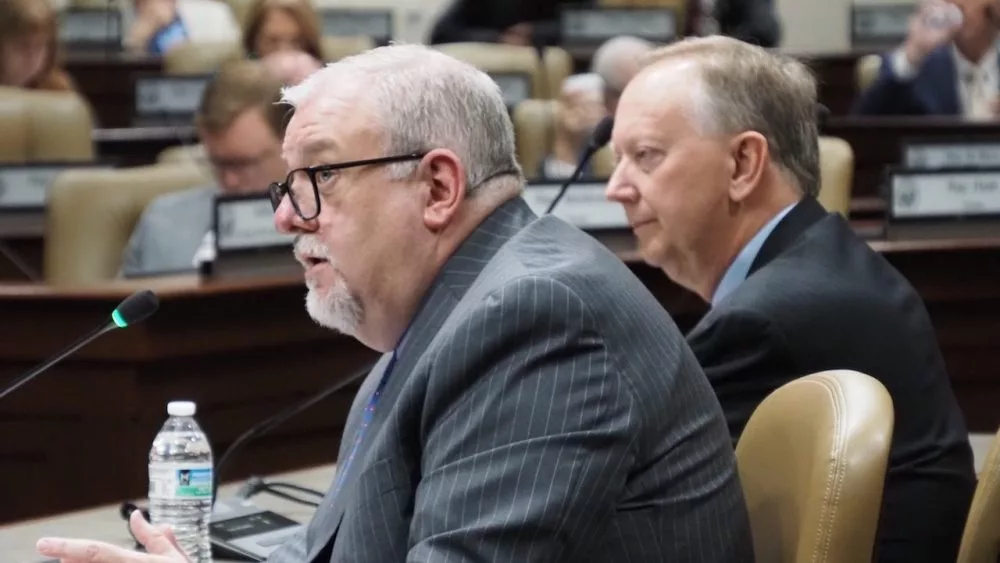Above: Department of Finance and Administration Secretary Jim Hudson (left) and State Budget Director Robert Brech answer questions about the 2025 state budget from lawmakers on Nov. 21, 2024. (Mary Hennigan/Arkansas Advocate)
By Antoinette Grajeda, Arkansas Advocate
Arkansas’ chief financial officer on Thursday attributed a $374.2 million decrease in net available revenue for the current fiscal year to a tax deadline extension due to severe weather and tax cuts in recent years.
Members of the Arkansas Legislative Council questioned Department of Finance and Administration Secretary Jim Hudson about a revised general revenue forecast released Wednesday that projects Fiscal Year 2025 net available revenue will reach $6.526 billion, a 5.4% decrease from FY 2024.
The FY 2025 surplus is expected to be $214.8 million, more than three times less than the $698.4 million surplus in FY 2024.
Because the governor issued executive orders authorizing the extension of the deadline for individual and corporate income tax payments to July 31, some of the revenue originally expected for FY 2025, which ends on June 30, will now shift to FY 2026, Hudson said.
“It’s not a net loss of revenue, it’s just more of a timing effect of it. So we’ll see some leakage of revenue both on the personal side and the corporate side out of FY 25 into FY 26,” Hudson said. “We’ve done some estimating on that, but we really don’t know how many people will take advantage of that yet.”
In a May 21 letter to the ALC chairs, Hudson said the revenue decline compared to FY 2024 is also expected because of the impact of individual and corporate income tax rate reductions passed in two special sessions of the 94th General Assembly.
State lawmakers in September 2023 approved legislation to cut the top corporate income tax rate from 5.1% to 4.8% and the top individual income tax rate from 4.7% to 4.4%. The rate changes took effect on Jan. 1, 2024.
The General Assembly approved another round of cuts in June 2024 that lowered the top corporate income tax rate from 4.8% to 4.3% and the top individual income tax rate from 4.4% to 3.9%, retroactive to Jan. 1, 2024. The tax cuts went into effect immediately upon the governor’s signature.
Year-to-date, net available revenues have declined by $224.7 million from the same time last year, resulting in collections that are $52.2 million over forecast at that point, according to the new DFA report.
Sales and use tax collections have also been marginally below forecast and individual income taxes have been above forecast primarily due to estimated payments. Corporate income tax collections are below forecast, according to the report.
“Corporate collections are notoriously volatile, they’re even more so I’d say right now just given the number of tax cuts that we’ve done with some retroactive effect, so there could be a forecasting component to this,” Hudson said.
DFA’s report, which was released Wednesday as required by state law, included revised forecasts for FY 2026 and FY 2027. Net available revenues are expected to reach $6.679 billion, an increase of 152.8 million above FY 2025. The projected FY 2026 surplus is $185.1 million.
FY 2027 net available revenue is expected to reach $6.88 billion, an increase of $201.3 million above FY 2026.
The revised projections are lower than the Nov. 14, 2024 forecast, which predicted $6.794 billion in net available revenue for FY 2026 and $6.997 billion for FY 2027. The adjustments are “largely attributable to shifts in economic conditions,” according to the May 21 report.
The revenue forecast is based on S&P Global Market Intelligence’s baseline economic forecast, according to the report. The S&P, one of three major stock market indexes, has had a volatile year as the market reacts to threats by President Donald Trump to levy steep tariffs.
“There’s a lot of speculation about the impact of tariffs, where the economy’s going,” Greenbrier Republican Rep. Stephen Meeks said Thursday. “…is any of that driving the need and is there anything looking forward that we need to be concerned about revenues coming into the state?”
Hudson responded that reductions made to the revenue forecast were “almost entirely driven by macroeconomic considerations.” Tariffs are a big component of forecasting, but Hudson noted it’s more the perception of the potential impact of tariffs that’s affecting the market instead of actual tariffs because many have been paused, he said.
Earlier this month, the United States and China agreed to lower steep tariffs for 90 days, States Newsroom reported. U.S. tariffs on Chinese goods dropped to a universal 10% baseline from the 145% Trump imposed in April. A 20% emergency tariff announced in February on all products because of illicit fentanyl chemicals in China remained in place.
The back and forth on tariffs has caused uncertainty, which the market hates, Hudson said. However, the state’s chief financial officer said he believes “the potential upside from tariffs could be significant” for Arkansas if the result is trade agreements that are more favorable to the U.S. than they are today.
“I think particularly for Arkansas, if our agri exports — we get access to certain foreign markets that we’re currently closed off to, that could be a significant benefit to the state,” he said. “But at this point, we don’t know what the actual long-term benefits will be. Because of the uncertainty, analysts have reduced the projected growth; we’re following suit.”
The Arkansas Advocate is a nonprofit, nonpartisan news organization dedicated to tough, fair daily reporting and investigative journalism that holds public officials accountable and focuses on the relationship between the lives of Arkansans and public policy.

